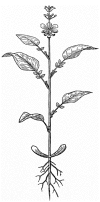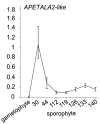Heterochronic genes in plant evolution and development
- PMID: 24093023
- PMCID: PMC3782661
- DOI: 10.3389/fpls.2013.00381
Heterochronic genes in plant evolution and development
Abstract
Evolution of morphology includes evolutionary shifts of developmental processes in space or in time. Heterochronic evolution is defined as a temporal shift. The concept of heterochrony has been very rewarding to investigators of both animal and plant developmental evolution, because it has strong explanatory power when trying to understand morphological diversity. While for animals, extensive literature on heterochrony developed along with the field of evolution of development, in plants the concept has been applied less often and is less elaborately developed. Yet novel genetic findings highlight heterochrony as a developmental and evolutionary process in plants. Similar to what has been found for the worm Caenorhabditis, a heterochronic gene pathway controlling developmental timing has been elucidated in flowering plants. Two antagonistic microRNA's miR156 and miR172 target two gene families of transcription factors, SQUAMOSA PROMOTOR BINDING PROTEIN-LIKE and APETALA2-like, respectively. Here, we propose that this finding now allows the molecular investigation of cases of heterochronic evolution in plants. We illustrate this point by examining microRNA expression patterns in the Antirrhinum majus incomposita and choripetala heterochronic mutants. Some of the more beautiful putative cases of heterochronic evolution can be found outside flowering plants, but little is known about the extent of conservation of this flowering plant pathway in other land plants. We show that the expression of an APETALA2-like gene decreases with age in a fern species. This contributes to the idea that ferns share some heterochronic gene functions with flowering plants.
Keywords: APETALA2; Ceratopteris; SPL; choripetala; heterochrony; incomposita; microRNA156; microRNA172.
Figures




References
-
- Alberch P., Gould S. J., Oster G. F., Wake D. B. (1979). Size and shape in ontogeny and phylogeny. Paleobiology 5 296–317
-
- Albert V. A., Gustafsson M, Di Laurenzio L. (1998). “Ontogenetic systematics, molecular developmental genetics, and the angiosperm petal,” in Molecular Systematics of Plants II eds Soltis D. E., Soltis P. S., Doyle J. J. (Dordrecht: Kluwer Academic Publishers; ) 349–374
-
- Allsopp A. (1967). Heteroblastic development in vascular plants. Adv. Morphog. 6 127–171 - PubMed
-
- Arber A. (1937). The interpretation of the flower: a study of some aspects of morphological thought. Biol. Rev. 12 157–184 10.1111/j.1469-185X.1937.tb01227.x - DOI
LinkOut - more resources
Full Text Sources
Other Literature Sources

